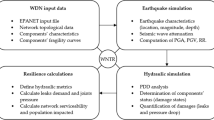Abstract
Extreme weather events such as heavy rains and floods are becoming more frequent and severe due to global warming, therefore leading to an increasing interest in methods to evaluate environmental consequences and mitigation strategies. Water supply systems (WSS) represent a class of safety-critical infrastructure prone to damage, with direct impact on public health. They can be cast in the class of cyber-physical systems, since their operation is governed by their physical behaviour—related to topology, fluid-dynamics and technology—which in turn is steered by operation policies and user behaviour—pump and valve management, demand–response mechanisms, etc. In this context, we propose an approach to estimate resilience in the indirect damage caused by a flood on a Water Supply System (WSS). To this end, we combine analysis of an inundation model, which computes the floodwater depth over time on the studied territory, and evaluation of a hydraulic network model by a Pressure-Driven Demand (PDD) approach, which also allows for demand–response mechanisms. Flood damage is assessed in terms of both lack of service experienced by inhabitants and length of pipeworks contaminated by floodwater. The approach is experimented on the WSS of Florence, Italy, which serves about 380,000 users and lies in a flood-prone territory. A sensitivity analysis is with respect to demand–response efficiency, speed, and start time.
Access this chapter
Tax calculation will be finalised at checkout
Purchases are for personal use only
Similar content being viewed by others
References
Abate A, Katoen J, Lygeros J, Prandini M (2010) Approximate model checking of stochastic hybrid systems. Eur J Control 16(6):624–641
Ashley ST, Ashley WS (2008) Flood fatalities in the United States. J Appl Meteorol Climatol 47(3):805–818
Arrighi C, Tarani F, Vicario E, Castelli F (2017) Flood impacts on a water distribution network. Natural Hazards Earth Syst Sci Discussions 2017:1–22. [Online]. Available: https://www.nat-hazards-earth-syst-sci-discuss.net/nhess-2017-205/
Bujorianu ML, Lygeros J (2004) General stochastic hybrid systems: modelling and optimal control. In: Proceedings IEEE Conference Decision Control, Nassau, Bahamas, pp 1872–1877
Cheung P, Van Zyl J, Reis L (2005) Extension of epanet for pressure driven demand modeling in water distribution system. Comput Control Water Ind 1:311–316
Christodoulou SE (2011) Water resources conservancy and risk reduction under climatic instability. Water Resour Manag 25(4):1059–1062
Emanuelsson MAE, Mcintyre N, Hunt CF, Mawle R, Kitson J, Voulvoulis N (2014) Flood risk assessment for infrastructure networks. J Flood Risk Manage 7(1):31–41
de Moel H, van Alphen J, Aerts JCJH (2009) Flood maps in Europe – methods, availability and use. Nat Hazards Earth Syst Sci 9(2):289–301
EU Parliament (2007) Directive 2007/60/EC, pp 27–34
IPCC (2013) Summary for policymakers. Climate change 2013: the physical science basis. Contribution of Working Group I to the Fifth Assessment Report of the Intergovernmental Panel on Climate Change, p 33
Galland J, Goutal N, Hervouet J (1991) A new numerical model for solving shallow water equations. Adv Water Resour 14(3):138–148
Hervouet J (2007) Hydrodynamics of free surface flows modelling with the finite element method, vol 1. Wiley, Hoboken
Khan SJ, Deere D, Leusch FDL, Humpage A, Jenkins M, Cunliffe D (2015) Extreme weather events: should drinking water quality management systems adapt to changing risk profiles? Water Res 85:124–136. [Online]. Available: http://doi.org/10.1016/j.watres.2015.08.018
Luh J, Royster S, Sebastian D, Ojomo E, Bartram J (2017) Expert assessment of the resilience of drinking water and sanitation systems to climate-related hazards. Sci. Total Environ 592:334–344. [Online]. Available: http://www.sciencedirect.com/science/article/pii/S004896971730596X
Lung T, Lavalle C, Hiederer R, Dosio A, Bouwer LM (2013) A multi-hazard regional level impact assessment for Europe combining indicators of climatic and non-climatic change. Glob Environ Chang 23(2):522–536 [Online]. Available: http://dx.doi.org/10.1016/j.gloenvcha.2012.11.009
Lygeros J, Prandini M (2010) Stochastic hybrid systems: a powerful framework for complex, large scale applications. Eur J Control 16(6):583–594
Methods H, Walski TM, Chase DV, Savic DA, Grayman W, Beckwith S, Koelle E (2003) Advanced water distribution modeling and management. Haestad Press, Waterbury
Merz B, Kreibich H, Schwarze R, Thieken a (2010) Review article “assessment of economic flood damage”. Nat Hazards Earth Syst Sci 10(8):1697–1724
Meyer V, Becker N, Markantonis V, Schwarze R, Van Den Bergh JCJM, Bouwer LM, Bubeck P, Ciavola P, Genovese E, Green C, Hallegatte S, Kreibich H, Lequeux Q, Logar I, Papyrakis E, Pfurtscheller C, Poussin J, Przyluski V, Thieken aH, Viavattene C (2013) Review article: assessing the costs of natural hazards-state of the art and knowledge gaps. Nat Hazards Earth Syst Sci 13(5):1351–1373
Rossman LA (1999) The EPANET programmer’s toolkit for analysis of water distribution systems. In: 29th Annual Water Resources Planning and Management Conference, Tempe, Arizona, United States, ASCE, Reston, VA, pp 1–10
Siew C, Tanyimboh TT (2012) Pressure-dependent EPANET extension. Water Resour Manag 26(6):1477–1498
Short MD, Peirson WL, Peters GM, Cox RJ (2012) Managing adaptation of urban water systems in a changing climate. Water Resour Manag 26(7):1953–1981
Walski T, Blakley D, Evans M, Whitman B (2017) Verifying pressure dependent demand modeling. Proc Eng 186:364–371. {XVIII} International Conference on Water Distribution Systems, {WDSA2016}. [Online]. Available: http://www.sciencedirect.com/science/article/pii/S1877705817313796
WHO (2011) Guidance on water supply and sanitation in extreme weather events, p 132. [Online]. Available: http://www.euro.who.int/en/health-topics/environment-and-health/water-and-sanitation/publications/2011/guidance-on-water-supply-and-sanitation-in-extreme-weather-events
World Economic Forum (2017) The Global Risks Report 2017 12th Edition Insight Report
Acknowledgements
We acknowledge the network operator Publiacqua SpA for the WSS hydraulic model of the city of Florence, Italy.
Author information
Authors and Affiliations
Corresponding author
Editor information
Editors and Affiliations
Rights and permissions
Copyright information
© 2019 Springer International Publishing AG, part of Springer Nature
About this chapter
Cite this chapter
Tarani, F., Arrighi, C., Carnevali, L., Castelli, F., Vicario, E. (2019). Flood Resilience of a Water Distribution System. In: Flammini, F. (eds) Resilience of Cyber-Physical Systems. Advanced Sciences and Technologies for Security Applications. Springer, Cham. https://doi.org/10.1007/978-3-319-95597-1_8
Download citation
DOI: https://doi.org/10.1007/978-3-319-95597-1_8
Published:
Publisher Name: Springer, Cham
Print ISBN: 978-3-319-95596-4
Online ISBN: 978-3-319-95597-1
eBook Packages: Computer ScienceComputer Science (R0)




